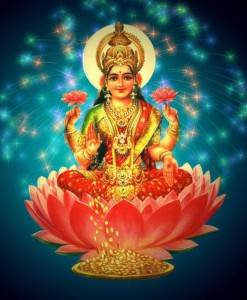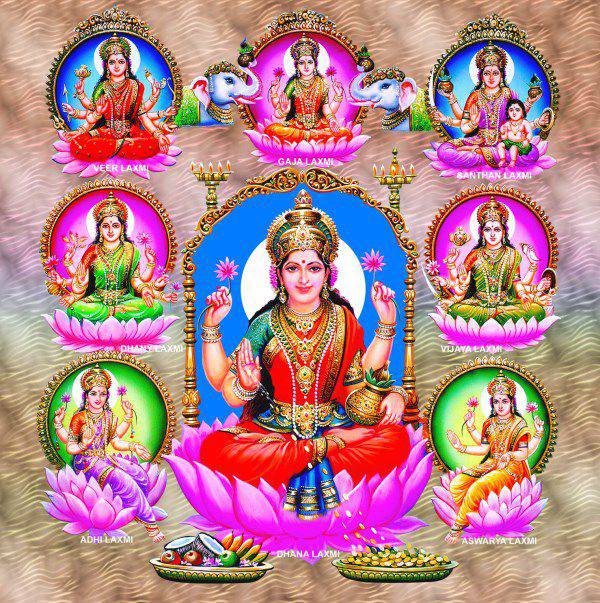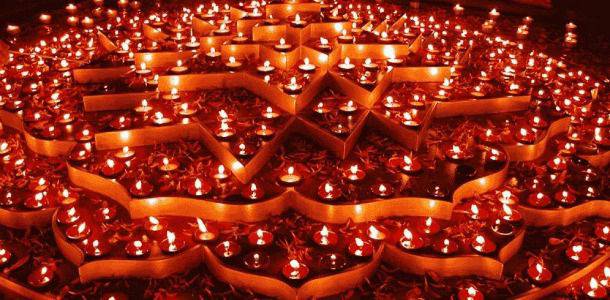No products in the cart.
Goddess Lakshmi – Hindu Goddesses and Deities
 ‘Shri’ or ‘Lakshmi’, as depicted in the Vedas, is the goddess of wealth and fortune, power and beauty. In her first incarnation, according to the Puranas, she was the daughter of the sage Bhrigu and his wife Khyati. She was later born out of the ocean of milk at the time of its churning. She, being the consort of Vishnu, is born as his spouse whenever he incarnates. When he appeared as Vamana, Rama and Krishna, she appeared as Padma (or Kamala), Sita and Rukmani. She is as inseparable from Vishnu as speech from meaning or knowledge from intellect, or good deeds from righteous-ness. He represents all that is masculine, and she, all that is feminine.
‘Shri’ or ‘Lakshmi’, as depicted in the Vedas, is the goddess of wealth and fortune, power and beauty. In her first incarnation, according to the Puranas, she was the daughter of the sage Bhrigu and his wife Khyati. She was later born out of the ocean of milk at the time of its churning. She, being the consort of Vishnu, is born as his spouse whenever he incarnates. When he appeared as Vamana, Rama and Krishna, she appeared as Padma (or Kamala), Sita and Rukmani. She is as inseparable from Vishnu as speech from meaning or knowledge from intellect, or good deeds from righteous-ness. He represents all that is masculine, and she, all that is feminine.
What is the meaning of Lakshmi?
Goddess Lakshmi means Good Luck to Hindus. The word ‘Lakshmi’ is derived from the Sanskrit word “Laksya”, meaning ‘aim’ or ‘goal’, and she is the goddess of wealth and prosperity, both material and spiritual. She is the goddess of prosperity, wealth, purity, generosity, and the embodiment of beauty, grace and charm.
Worship of a mother goddess has been a part of Indian tradition since its earliest times. Lakshmi is one of the mother goddesses and is addressed as “mata” (mother) instead of just “Devi” (goddess). Goddess Lakshmi is worshipped by those who wish to acquire or to preserve wealth. It is believed that Lakshmi (wealth) goes only to those houses which are clean and where the people are hardworking. She does not visit the places which are unclean/dirty or where the people are lazy.
She is the active energy of Vishnu. Her four hands signify her power to grant the four Purusharthas (ends of human life), Dharma (righteousness), Artha (wealth), Kama (pleasures of the flesh), and Moksha (beatitude). Representations of Lakshmi are also found in Jain monuments. In Buddhist sects of Tibet, Nepal and Southeast Asia, goddess Vasudhara mirrors the characteristics and attributes of Hindu goddess Lakshmi, with minor iconographic differences.
Goddess Lakshmi Iconography
In Lakshmi’s iconography, she is usually described as enchantingly beautiful and sitting or standing on an open eight petaled lotus flower on a lake, and holding lotuses in each of her two hands. It is because of this, perhaps, that she is named as Padma or Kamala. She is also adorned with a lotus garland. Very often elephants are shown on either side, emptying pitchers of water over her, the pitchers being presented by celestial maidens. Her colour is variously described as dark, pink, golden yellow or white. While in the company of Vishnu, she is shown with two hands only. When worshipped in a temple (separate temples for Lakshmi are rather rare) she is shown seated on a lotus throne, with four hands holding Padma, Sankha, Amrtakalasa (pot of ambrosia) and Bilva fruit. Sometimes, another kind of fruit, the Mahaliilga (a citron) is shown instead of Bilva. Cascades of gold coins are seen flowing from her hands, suggesting that those who worship her gain wealth. When shown with eight hands, bow and arrow, mace and discus are added. This is actually the MahaLakshmi, an aspect of Durga.
If Lakshmi is pictured as dark in complexion, it is to show that she is the consort of Vishnu, the dark god. If golden yellow, that shows her as the source of all wealth. If white, she represents the purest form of Prakarti (nature) from which the universe had developed. The pinkish complexion, which is more common, reflects her compassion for creatures, since she is the mother of all. The lotuses, in various stages of blooming, represent the worlds and beings in various stages of evolution.
The fruit stands for the fruits of our labours. How-ever- much we may toil and labour, unless the Mother is gracious enough to grant the fruits of our labour, nothing will be of any avail. If the fruit is a coconut-with its shell, kernel and water-it means that from her originate the three levels of creation, the gross, the subtle and the extremely subtle. If it is a pomegranate or a citron, it signifies that the various created worlds are under her control and that she transcends them all. If it is a bilva fruit which, incidentally, is not very tasty or attractive, but which is extremely good for health-it stands for Moksha, the highest fruit of spiritual life. Amshtakalasa also signifies the same thing, viz., that she can give us the bliss of immortality. In some of the sculptural depictions of Lakshmi, the owl is shown as her carrier-vehicle.
Goddess Laxmi Vrat and Festival
Although Goddesses Lakshmi is worshipped daily, the festive month of October is Lakshmi’s special month. The festivals of Diwali and Sharad Purnima (Kojagiri Purnima) are celebrated in her honour. Diwali spiritually signifies the victory of light over darkness, knowledge over ignorance, good over evil, and hope over despair.
Gaja Lakshmi Puja is another autumn festival celebrated on Sharad Purnima, in many parts of India, on the full-moon day in the month of Ashvin (September–October). The Sharad Purnima, also called Kojaagari Purnima or Kumar Purnima is a harvest festival celebrated on the full moon day of the Hindu lunar month of Asvin. It marks the end of monsoon. There is a traditional celebration of the moon and is also called the ‘Kaumudi celebration’, Kaumudi meaning moonlight. On Sharad Purnima night, goddess Lakshmi is thanked and worshipped for the harvests.
Lakshmi Mantra
- Lakshmi Beej Mantra
ॐ ह्रीं श्रीं लक्ष्मीभयो नमः॥
Om Hreem Shreem Lakshmibhayo Namah॥
- Mahalakshmi Mantra
ॐ श्रीं ह्रीं श्रीं कमले कमलालये प्रसीद प्रसीद ॐ श्रीं ह्रीं श्रीं महालक्ष्मयै नम:॥
Om Shreem Hreem Shreem Kamale Kamalalaye Praseed Praseed
Om Shreem Hreem Shreem Mahalakshmaye Namah॥
- Lakshmi Gayatri Mantra
ॐ श्री महालक्ष्म्यै च विद्महे विष्णु पत्न्यै च धीमहि तन्नो लक्ष्मी प्रचोदयात् ॐ॥
Om Shree Mahalakshmyai Cha Vidmahe Vishnu Patnyai Cha Dheemahi
Tanno Lakshmi Prachodayat Om॥
Goddess Lakshmi Avatars
Lakshmi has 8 primary forms. These 8 forms are personified as Ashta Lakshmi (Ashtalakshmi). These eight forms are as follows:
- Dhanya Lakshmi: Dhanya means grains. Lakshmi is the Goddess of the Harvest and the Devi who blesses with abundance and success in harvest. Harvest is a time of abundance after a long period of patience and tending to fields. This symbolizes the inner harvest, that, with patience and persistence, we obtain the abundance of inner Joy through the blessing of Dhanya Lakshmi.
- Adi Lakshmi: Mother Lakshmi resides with Lord Narayana in Vaikuntha, the abode of Lord Narayana. She is known as Rama, which means bringing happiness to the mankind. She is also known as Indira (who holds lotus or purity). In this form, Lakshmi is normally seen serving Shri Narayana. Lord Narayana is omnipresent. Adi Lakshmi or Rama Lakshmi serving Shri Narayana is symbolic of her serving the whole creation. Adi Lakshmi and Narayana are not two different entities but one only. Lakshmi is Shakti. Lakshmi is the Power of Narayana.
- Dhairya Lakshmi: This form of mother Lakshmi grants the boon of infinite courage and strength. Those, who are in tune with infinite inner power, are always bound to have victory. Those who worship mother Dhairya Lakshmi lead a life with tremendous patience and inner stability.
- Gaja Lakshmi: In the holy book of Shrimad Bhagavata the story of the churning of the ocean by Gods and demons is explained in detail. Sage Vyasa writes that Lakshmi came out of the ocean during the churning of the ocean (Samudra Manthan). So she is known as a daughter of the ocean. She came out of the ocean sitting on a full-bloomed lotus and also having lotus flowers in both hands with two elephants by her sides holding beautiful vessels.
- Santan Lakshmi: In the family life, the children are the greatest treasure. Those who worship this particular form of Shri Lakshmi, known as a Santan Lakshmi, are bestowed with the grace of mother Lakshmi and have wealth in the form of desirable children with good health and a long life.
- Vijay Lakshmi: Vijay is victory. Vijay is to get success in all undertakings and all different facets of life. Vijay is to conquer the lower nature. Hence those, with grace of mother Vijay Lakshmi, have victory everywhere, at all time, in all conditions. Victory to Vijay Lakshmi!
- Dhana Lakshmi: Dhana is wealth. Wealth comes in many forms: Nature, Love, Peace, Health, Prosperity, Luck, Virtues, Family, Food, Land, Water, Will Power, Intellect, Character, etc. With the grace of mother Dhana Lakshmi we will get all these in abundance.
- Vidya Lakshmi: Vidya is education. Serenity, Regularity, Absence of Vanity, Sincerity, Simplicity, Veracity, Equanimity, Fixity, Non-irritability, Adaptability Humility, Tenacity, Integrity, Nobility, Magnanimity, Charity, Generosity and Purity are the eighteen qualities imbibed through proper education that only can give immortality.

Goddess Lakshmi Temples
Chattarpur Mandir
Chattarpur Mandir is located at a distance of approximately 4 km from the famous Qutab Minar in the Mehrauli area of Delhi. It is a beautiful monument which is built in both the South Indian as well as North Indian style of architecture.
Chaurashi Temple
The Chaurashi Temple is situated at Bhramour which is 65 kilometers from Chamba Valley in the state of Himachal Pradesh. The main temples of Lakshmi Devi, Ganesh and Manimahesh and Nar Singh are called as Chaurashi Temples.
Maha Laxmi Temple
Mahalakshmi Temple in Mumbai is one amongst the oldest shrines in the city. It is Located on B. Desai Road at Breach Candy in Mumbai, it is among the most visited temples of the city. The temple is renowned for its exclusive history and devoutness.
Sripuram Golden Temple
The golden temple of Sripuram is a spiritual park situated at the foot of a small range of green hills in a place known as “Malaikodi” in the city of Vellore in Tamil Nadu. The temple is at the southern end of the city of Vellore, at city Tirumalaikodi. The Thirumalaikodi is about 8 kms from Vellore.


